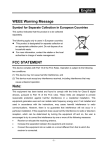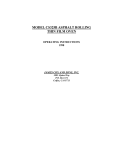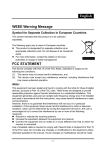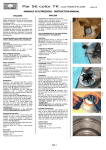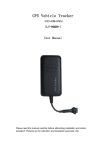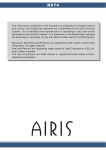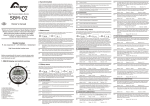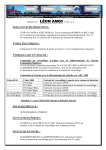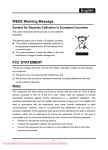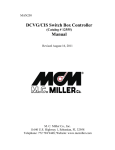Download Pulse Generator - The M.C. Miller Company
Transcript
Pulse Generator User Manual Introduction The MCM Pulse Generator (PG) is used in conjunction with the WaveForm Analyzer (WFA) to measure ON/OFF (soil and pipe IR drop free) pipe-to-soil potentials on impressed current cathodic protection rectifiers. The PG has two modes of operation: WFA Mode: The WFA Mode is the normal mode of operation. It is used to measure the ON/OFF pipe-to-soil potentials with the WFA; Interrupter Mode: In the interrupter mode, the PG functions as a standard current interrupter with a variety of user selectable timing cycles. WaveForm Analyzer/Pulse Generator System Technical Discussion The WFA is a microprocessor based handheld voltmeter. It uses a complex computer algorithm to measure the ON/OFF (IR drop free) pipe-to-soil (P/S) potentials in impressed current cathodic protection systems. In order for the WFA to accurately calculate the OFF potential, a PA must be installed in each rectifier or current source affecting the location where the P/S measurement is being made. The PG interrupts the output rectifier in which it is installed on a precise timing cycle. This interruption generates the precisely timed zero current pulse which is required by the WFA to accurately calculate the OFF potential. Pulse Generators are low cost and designed to be permanently installed in the rectifier, turned on, and left to operate permanently. As stated earlier, the WFA uses a complex algorithm or set of computer instructions to calculate the ON/OFF P/S potential. The algorithm consists of the following steps: 1. The WFA captures a digital picture of the P/S potential waveform by recording thousands of voltage readings on the waveform; 2. Digital signal processing techniques are used to filter out any induced AC or 60cycle noise within the waveform; 3. The ON potential reading is calculated; 4. The IR drop contribution from the six (6) Pulse Generators having the greatest influence on the reading is determined by analyzing the zero current pulses from the Pulse Generators; 5. Once the total drop contribution is known, the OFF potential reading is calculated by subtracting the IR drop from the ON value. Note: The WFA algorithm includes the IR drop contribution from the six (6) rectifiers (or up to six (6)) having the largest IR drop. To date, in extensive field-testing conducted on numerous cross-country pipelines, tank farms, and industrial facilities, no location has been found where more than five (5) rectifiers were influencing the reading. Revised – July 30, 2001 RE 2 Installing the Pulse Generator General Installation The design of the Pulse Generator permits it to be permanently installed in a cathodic protection rectifier. Its small size (6.5” x 5” x 2.5”) allows for easy installation inside most existing rectifiers. The following guidelines should be followed when installing the PG: 1. The PG should be installed vertically, i.e. the heat sink cooling fins should be vertical, especially when used with rectifiers having a current output above 40 amps. Mounting the PG vertically insures maximum heat dissipation; 2. The design of the PG permits it to be installed within the rectifier cabinet. If there is not sufficient room within the rectifier cabinet, the PG should be mounted in a separate waterproof enclosure; 3. There should be sufficient airflow around the PG, especially if the rectifier is operating at or above 40 amps of current output; 4. The PG should be energized (AC power should be applied) first, and then the rectifier should be energized; 5. The RED LED on the Pulse Generator printed circuit board is lit when the PG is on or is conducting current. AC Power The Pulse Generator requires either 110 volt or 220 volt / 60-hertz single phase AC power for proper operation. A four (4) foot long, three (3) conductor AC power cable is supplied with the PG. The three (3) conductors are colored coded as follows: • • • BLACK – AC power hot wire; WHITE – AC power neutral wire; GREEN – Safety ground wire. The safety ground is connected to the Pulse Generator case (BLACK heat sink). The RED slide switch on the PG is used to select the AC supply voltage. The slide switch should show 115V when a 110/115-volt AC supply is used. The slide switch should show 230V when a 220/230-volt AC supply is used. Note: Before applying AC power, make sure the slide switch is set to the actual supply voltage. The Pulse Generator will be damaged if the supply voltage selector switch is not set to the actual supply voltage. The PG draws less than .6 watts from the AC supply. The PG will function properly when the supply voltage varies ± 15% from the rated AC supply voltage. AC power should be supplied to the PG before the rectifier is turned on. (Turn on the PG FIRST, and then turn on the rectifier.) Revised – July 30, 2001 RE 3 Rectifier Connections The Pulse Generator must be installed in series … in either the positive or negative output leg of the rectifier. Two lugs are provided on the PG for the connection into one of the rectifier output legs. These lugs will accept up to one #6 AWG cable. The lugs are marked with either a plus (+) sign or a negative (-) sign on the printed circuit board beneath the lugs. The PG only allows DC current to flow from the positive (+) lug to the negative (-) lug. When connecting the PG in the rectifier’s positive leg (rectifier anode connection), the PG positive terminal is connected to the rectifier’s positive cable and the PG negative terminal is connected to the anode header cable. When installing the Pulse Generator, MCM recommends that it be installed on the inside of the rectifier and wired so that the PG may take advantage of the lightning protection circuitry on the rectifier’s DC output. Any lightning induced surges on either the structure cable or anode cable should be clamped by the rectifier lightning arrestor prior to being clamped by the voltage surge suppression circuitry on the PG. Mode Selection Switch The ten-position slide DIPswitch on the PG is used to select the two (2) PG operating modes. Care and Maintenance The Pulse Generator has been designed to operate reliably and accurately while installed in standard cathodic protection rectifiers. While no specific regular maintenance procedures are required, MCM recommends the following guidelines be followed: 1. While the PG printed circuit boards have been conformal coated for environmental protection, the PG should not be exposed to direct moisture. The design of the PG allows it to be mounted within a waterproof enclosure. 2. The PG should be mounted so the heat sink cooling fins are vertical. This will insure maximum heat dissipation from the heat sink. Troubleshooting A number of possible PG problems and suggested remedies are listed below: 1. No Rectifier Current Output – There will be no current output from the rectifier if: a. The Pulse Generator polarity has been reversed when connected to the rectifier. When the PG is wired into the positive rectifier leg, the PG positive terminal goes to the rectifier and the PG negative terminal is connected to the anode header cable. When the PG is wired into Revised – July 30, 2001 RE 4 the rectifier negative leg, the PG positive terminal is connected to the structure cable and the PG negative terminal is connected to the rectifier negative; b. There is no AC power to the Pulse Generator. 2. Pulse Generator LED is always OFF – Check: a. The Mode Selection 10 Position DIP Switch. Insure it is set properly; b. Insure there is AC power to the Pulse Generator. 3. Pulse Generator LED is always ON – Check: a. The Mode Selection 10 Position DIP Switch. Insure it is set properly. WFA Mode The WFA mode is the standard operating mode for the PG. The PG must be in the WFA mode in order for the WaveForm Analyzer to take correct OFF potential readings. The ten (10) position DIP switch should be set as shown below for the WFA mode: | | | | | | | ON OFF | | | SW 1 2 3 4 5 6 7 8 9 10 Interrupter Mode The ten (10) position DIP switch may be used to set the Pulse Generator in the current interrupter mode. In this mode, the PG functions as a standard current interrupter. The PG turns the rectifier ON and OFF at the timing cycle set by the DIP switches. The ten (10) DIP switches are divided into the following three (3) groups: • • • Switch #1: Mode Selection – When Switch #1 is in the OFF position, the PG is in the WFA mode. When Switch #1 is in the ON position, the PG is in the interrupter mode; Switches #2 - #6: OFF Cycle Time – These five (5) switches are used to set the off cycle time for the PG. The five (5) are used to form a binary number between 0 and 32, with Switch #2 being the most significant bit and Switch #6 being the least significant bit. The OFF cycle is calculated using the following formula: OFF cycle (seconds) = ((number on the switches 2-6) + 1)/2 Switches #7 - #10: ON Cycle Time – These four (4) switches are used to set the on cycle time for the PG. The four (4) switches form a binary number between 0 and 16, with Switch # 7 being the most significant bit in the binary number and Switch #10 being the least significant bit. The ON cycle is calculated using the following formula: ON cycle (seconds) = (OFF cycle) * (number on the switches 7-10) Note: If the above explanation is confusing, a table showing the Pulse Generator switch settings and interrupter cycle times is provided at the end of this manual. Revised – July 30, 2001 RE 5 For additional information or technical assistance, contact the M. C. Miller Co., Inc. M. C. Miller Co., Inc. 3020 Aviation Blvd. Vero Beach, FL 32960 Tel: 772-794-9448 Fax: 772-794-9908 [email protected] www.mcmiller.com Mode Selection Switch Summary Table SW1 | | | | | | | | | | | | | | | 0 | SW2 0 0 0 0 0 0 0 0 0 0 0 0 | | | 0 0 SW3 0 0 0 | | | | 0 0 0 0 | | | | 0 0 SW4 0 0 | | | | | 0 0 | | | | | | | 0 SW5 0 | | | | | | | | | | | | | | | 0 SW6 | | | | | | | | | 0 | 0 0 | | | 0 SW7 0 0 0 0 0 0 0 0 | 0 0 0 0 0 | | | SW8 0 0 0 0 0 0 | | 0 0 0 0 0 0 | | | SW9 0 0 0 0 | | | | | | | 0 0 | | | | SW10 | | | | 0 | | | | | | | | 0 | | | OFF ON 1sec 1sec 2sec 2sec 4sec 4sec 8sec 8sec 8sec 16sec 8sec 24sec 8sec 56sec 8sec 120sec 1.5sec 4sec 2sec 5.5sec 3.5sec 9.5sec 3.5sec 3.5sec 16sec 16sec 16sec 32sec 16sec 240sec xxxxx xxxxx Always On MODE INTER INTER INTER INTER INTER INTER INTER INTER INTER INTER INTER INTER INTER INTER INTER WFA INTER Legend | 0 OFF ON INTER WFA = Switch ON = Switch OFF = OFF Cycle Timing = ON Cycle Timing = Interrupt Mode =WaveForm Analyzer Mode Revised – July 30, 2001 RE 6






